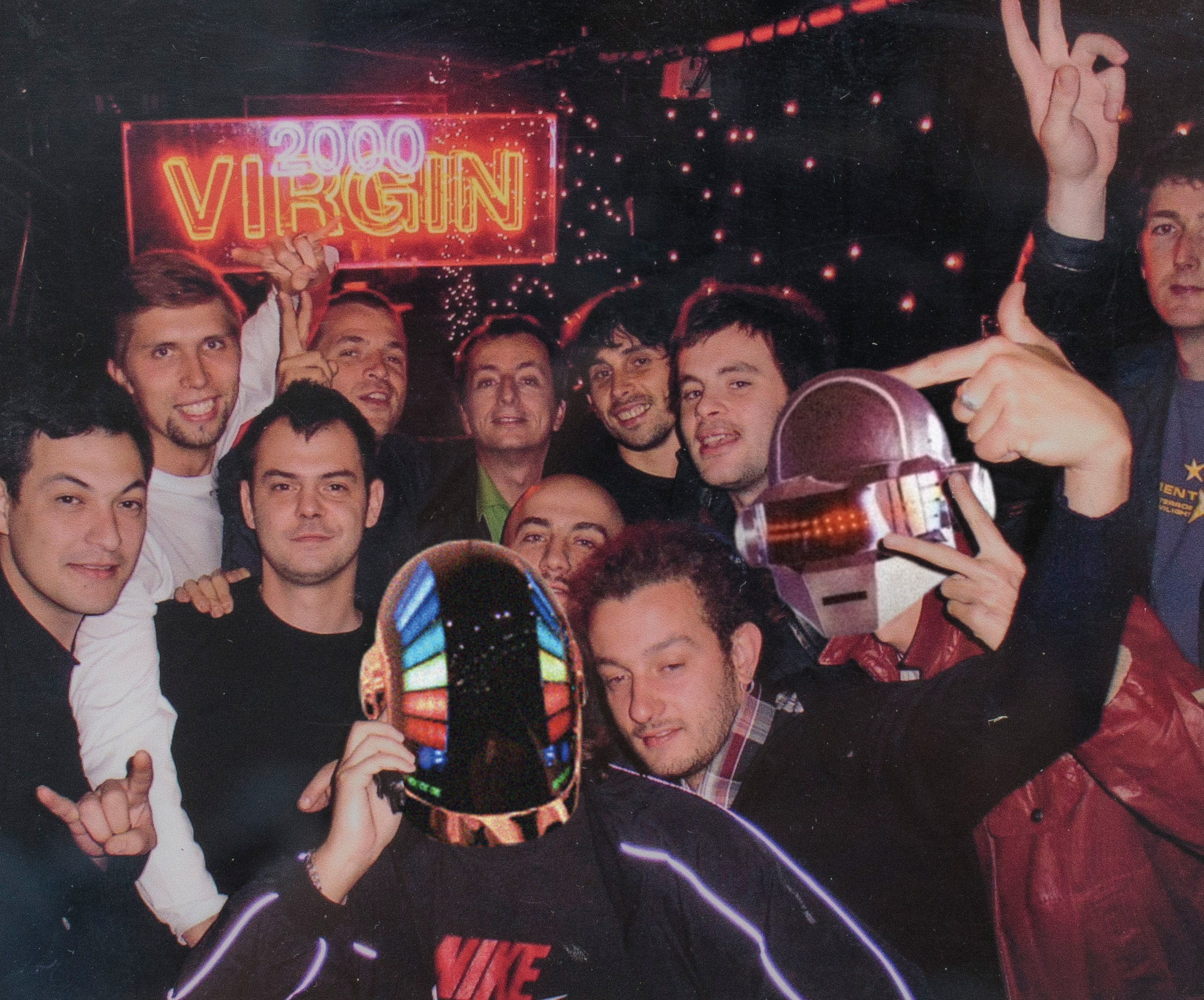Capital Frequencies: Underground Paris Radio in the ’90s
Underground radio. Amateur, community grown, and unconditionally free. In France, as pretty much everywhere in the world, each region had one or more stations of this kind in the pre-internet age: Sauvagine in Bordeaux, Radio Béton in Tours, Ellébore in Salvoie, Grenouille in Marseille, Couleur 3 for the East, all the way from Switzerland – an exhaustive list is beyond the remit of this article, but there were dozens in total.
Towards the second half of the ’90s, a brief twist of the tuning knob on a Parisian radio was potentially dizzying, especially in the early evening or on the weekend. FG (98.2), a station initially aimed at the gay community before progressively opening up to a larger audience, had a daily show called The Happy Hour, hosting players from the electronic music scenes of France and abroad, and broadcasted new, exclusive as well as classic cuts.
Beyond the guest DJs invited to perform live in the evening, resident DJs crafted selections of a sustained quality that would be hard to imagine in such proportions on FM radio today: DJ Deep, DJ Gregory and Alex from Tokyo delivered deep house on weekdays around lunchtime; Sven Love and Greg Gauthier broke the Sunday afternoon haze with their hour of garage, just before the Hometown and Rangerz crews deployed their two hours of Chicago house and UK garage. Patrick Vidal, meanwhile, brought Balearic beats, while the yet-to-turn millionaire Bob Sinclar, offered a disco and house show.
On Générations (88.2), the daily program Original Bombattak hosted pretty much all the members of the French rap scene which, at the time, was riding high: TimeBomb, 113, Mafia Trece, Fonky Family, ATK, La Brigade and Busta Flex, among many others. Resident DJs – Lorent, Bronco, Fab, etc. – had their weekly spots, spinning ’80s and ’90s R&B, choice tracks of jazz-funk or American rap from the under-underground like Fondle’em or Project Blowed.
Certain community radio stations offered more rock-inflected schedules, of considerable erudition but without the usually implicit pedantry. Most notable were Aligre FM’s three weekly shows: Monday’s Songs of Praise catered to noise rock, free rock and outsider players; Wednesday’s Planète Claire brought you the indie rock that Bernard Lenoir hadn’t selected for France Inter; and Helter Skelter came on Fridays with post-rock and neo-psychedelic stuff before it started to add electronic music from Warp or Mego. On FPP (106.3), a station with a variety of rap slots, there was one incredibly eclectic show that was absolutely seminal for me, since it threw up a whole host of songs that I still hold close to my heart – from rock to house to hip hop. It was called Mondial Twist, and I felt at the time like I was the only one who knew about it.
Diverse musical tastes, so widespread today, were already emerging in the aesthetics of underground Parisian FM two decades ago.
Finally, there was of course Nova, whose scheduling grid followed the mixed-bag principle, which transitioned, mid-afternoon, from salsa to techno to reggae to New Wave without anyone batting an eyelid. The station’s in-house and guest DJs all generally followed this undefined rule of thumb, which meant that the very same few minutes of house gained a different tonality on FG than when heard on Nova. Similarly for rap: the same track sounded different when mixed by DJ Gilb’r or by DJ Fab. Which isn’t to say that Nova mixed better than FG or Générations: things just had, perhaps, more of a “happening” quality on their end of the airwaves. Sometimes you felt like listening to two straight hours of house or rap, with a handy tracklist offered at the end, rather than braving Nova’s rollercoasters without the slightest explanation. But sometimes you simply spent whole weekends locked into the Novamix.
With a musical environment of such density, you invariably kept a blank tape in your radio cassette player, ready to hit “record.” These hastily recorded FM mixtapes, later shoved in a Walkman, were the principal means of musical discovery until the arrival of downloads, and MP3 players. Those were (and still are for the hangers-on) little lo-fi montages. The songs were rarely played in their entirety, strung together by scraps of voiceover announcing or revealing track titles. You’d also hear jingles and ads, or the first seconds of a not-so-great track because it’d taken you a little while to hit the pause button.
The sound quality of the recording might get patchy, either because of reception issues, or because the tape was worn from heavy usage. When you heard an amazing track play, you knew there was a possibility you’d never hear it again, which is what made the mixtape so precious: everything came down to seizing the moment, like trying to memorize the vividness of a dream to which you just woke up. You’d sometimes, in a panic, lose a potentially irretraceable track, so hurriedly had you pressed down on REC to capture yet another.
For our future historians, these mixtapes will constitute vibrant artifacts of pre-internet musical passion: they capture the focus, the labor, the lapses in judgment and evolutions of taste. Listening back to these intimate recordings, you realize that diverse musical tastes, so widespread today, were already emerging in the aesthetics of underground FM – Parisian, as it happens – two decades ago. The rough cutting between some French rap and a slice of deep house, followed by a bit of Latin funk, and a post-rock track, was already par for the course.
“People don’t believe me when I say this, but we really did listen to everything!” exclaims Loïc Dury, DJ and programming director at Nova from 1986 to 1998. Sitting in an armchair from which he often springs, propelled by the energy of his memories, he goes on, “We bought everything because you had to hear everything, that’s just how it was. If we missed this or that record, we kept thinking that nobody would listen to it for us and that it would just get lost.”
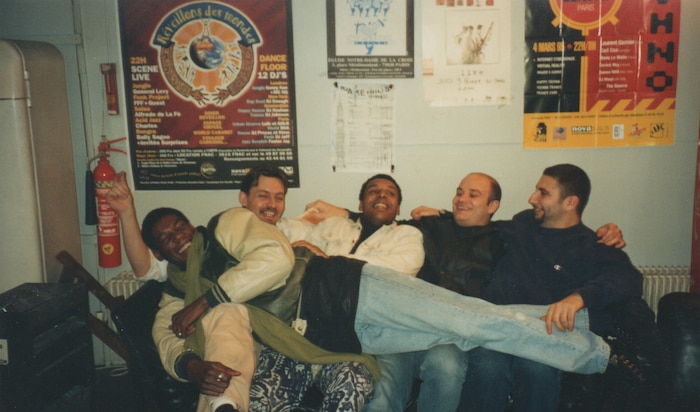
Now in his fifties, he’s handsome, dashing, with penetrating blue eyes. You could write an entire article about his life. Let’s just say that after a spell in Belgian prison, in 1983, because of a weed transaction gone wrong, the young man managed to slip through the cracks during a 48-hour discharge, slipped off to France, had a child and, with it, a need to generate a decent income, which at that point was no easy feat considering his legal status.
One night, perched in the attic room in the Hauts-de-Seine (just outside Paris) that has become his home, he hears a job offer on Radio Nova: the team is recruiting. He runs out of the house and into the nearest telephone booth only to be told that the position’s already been filled. Frazzled, he vents his frustration, somehow succeeding in amusing his interlocutor, who suggests he swing by their offices. There, he meets Jean-Yves Lafesse, one of the station’s leading figures, and the Saint-Paul Jews, a group of funk fans who would later form French band the Malka Family. They ask Loïc, well-versed in the genre, if he’ll organize a party under the patronage of Actuel, the French magazine run by Jean-François Bizot, the man who launched Radio Nova on 101.5.
And so it goes… the young father starts regularly helping out here and there at the radio and at the newspaper, both located on Rue du Faubourg Saint-Antoine, near Bastille, and strikes somewhat of a friendship with Bizot. In 1987, with no warning, director of programming Jean-Pierre Lentin leaves and doesn’t come back. In the weeks that follow, the radio’s playlist remains on loop and listeners start complaining.
So one day, Loïc makes his move, walks into the deserter’s office, gets out a pile of his favorite records, and politely demands that Marc H’limi11Today’s current program director of Nova and, at the time, responsible for recording the records to the tapes for broadcast. integrate his personal music selection into the rotation. Over the next few months, the audience triples. “I know it sounds weird but in those days, Nova, basically, played two styles: African music and Prefab Sprout,” Loïc recalls, “I brought funk, jazz, the second wave of hip hop and the early beginnings of house and techno. The end of the ’80s was a very intense time for Nova. And then we had another explosion, in the mid-’90s, with the Novamix sessions, among other things.”
The Novamix was a spot open to both guest and resident DJs, which, originally, followed La Grosse Boule, the daily evening show hosted by Edouard Baer and Ariel Wizman with a great deal of free spirit. During the Novamix, David Blot22The current presenter of Nova Club was, at the time, in charge of a segment tipping people off to interesting events. made it a point to play Masters At Work pretty much daily, and at peak hours.
The Novamix idea of “residency” was somewhat flexible, since Loïc and Gilbert (now “Gilb’r”) weren’t always able to find guests. “We’d come back from the Rough Trade store with a raft of happy hardcore, and invent there and then an English DJ as an alibi,” remembers Loïc. “Ariel, Gilbert and I, we bought enough records of all genres to fill dozens of imaginary DJ sets!”
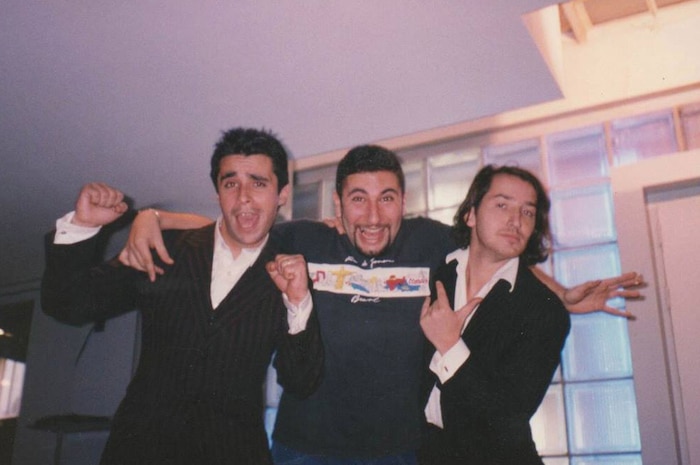
In 1995, Novamix was extended into the weekend. The idea came from a Belgian Radio Station, Radio 21, where Marc Moulin worked – to make a kind of “radio within a radio”, offering a new and exclusive non-rotation programming, from Friday to Sunday evenings. Nova covered this large slot with, among others: Dee Nasty, Laurent Garnier, Cut Killer, Gilles Peterson, legendary selector Lord Zeljko, DJ Clyde (from NTM), Dimitri From Paris, Ivan Smagghe, Ludovic Navarre AKA Saint Germain, DJ Deep and, of course, Loïc and Gilbert.
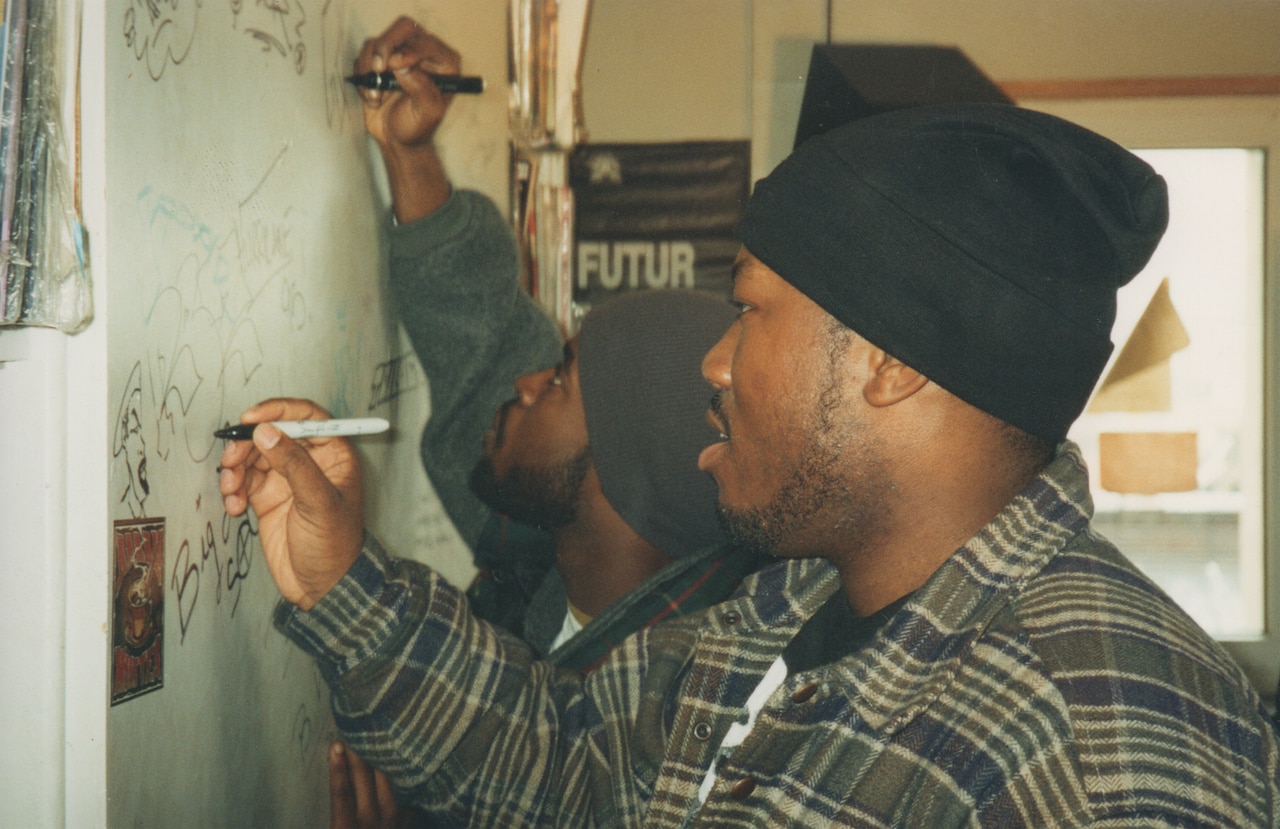
Guests from abroad soon made themselves available: Lots of English jungle DJs (a genre that Gilbert full-heartedly embraced between 1994 and 1997); a good number of American hip hop DJs stopped by as they passed through Paris with their groups, figures from Chicago’s second wave of house (Gemini, Derrick Carter, DJ Sneak…); Daft Punk, well before Homework.
Spending your weekend tuned into 101.5 had a vertiginous quality to it: behind this music bursting with freshness, you could smell the studio vibe: the private jokes, the spliffs, the familial spirit of a subculture. Sometimes the mixes would welcome a small audience, “nowhere close to the 200 people we had in the late ’80s on Dee Nasty’s first show,” Loïc clarifies, “but a decent crowd nonetheless. Thomas Bangalter often stopped by, both before and after Daft Punk’s ascendency. They knew every single Dance Mania record, their absolute reference. Feadz was there too, he was, like, 14 years old, tagging along with his big sister!”
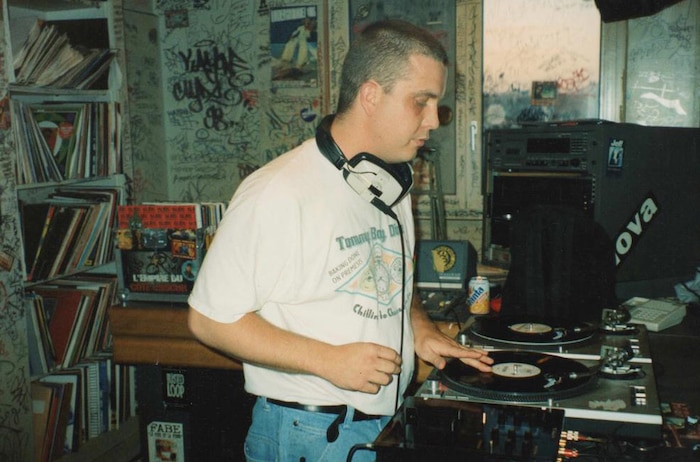
The international guests weren’t always easy to deal with. Loïc remembers one particular occasion, with House of Pain. “We invited them to the station, during the ‘Jump Around’ days. The guys show up, and it’s fairly obvious they aren’t in the greatest mood. But K-Mel from Alliance Ethnik, a huge fan of theirs, is there, and he won’t leave them alone, eager to freestyle with them and insistent beyond belief. House of Pain start by refusing, point blank, they don’t give a crap, but then we explained that Alliance Ethnik are big in France, we show them articles and magazine covers and eventually they figure, ‘OK, let’s freestyle with this guy.’ As the instrumental track hits, a very excited K-Mel, takes the mike first, before the House of Pain boys. But very quickly, it becomes clear that he’s in way over his head, he’s rapping like an amateur with embarrassing improvs: it was really awkward. The House of Pain gang were ruthless: this guy’d been hounding them and was making a fool of himself. They interrupted him and came down hard, live, over the beat. Everyone knew that K-Mel wasn’t a great rapper, but that day he really took a beating.”
Gilbert also remembers the heady days fondly. “I don’t mean to brag, but I still meet a lot of people, listeners and musicians, who tell me that the Novamix played a massive part in their musical education. During one period, I think that Nova really was the best radio station in the world, or in any event, the only radio to have such a programming. I’d meet people from all over the world who tuned to 101.5 whenever possible. We were pretty out there with Loïc: we’d mix using three different consoles, we’d cable the TV into our mix too sometimes, and now and then, it was more chaos than anything else…”
Dury recalls that with the arrival of the first modems, around 1995, the duo would tune directly into NYPD radio communications and incorporate certain agitated frenetic exchanges into their mix. “The day of the Oklahoma City bombing, the police were going out of their minds,” explains Gilbert. “And we layered that over what we were playing. Nowhere else have I ever had such a feeling of freedom.”
I wanted the radio to be a comfortable listen. It’s not like I was playing the avant-garde stuff I listened to at home!
The playlists and the overall programming were elaborated over the course of rather enthusiastic free-form meetings where Loïc and Gilbert, alongside fellow hosts – and experts – Bintou Simporé and Rémy Kolpa Kopoul, would bat ideas about together. Loïc got the final say. “Sometimes, Bintou or Rémy would propose a track off a world music or salsa record: I’d tell them about the track I liked better, off that particular record, and that was the one we’d go with. I took it all very seriously, I wanted to be as precise as possible. I was inspired by the daily divisions in programming like at Couleur 3 in Switzerland: fresh mornings, groovy afternoons, and deep evenings... I wanted the radio to be a comfortable listen: it wasn’t total complete freestyle. It’s not like I was playing the avant-garde stuff I listened to at home!”
In 1997, after ten years of intense and dedicated service, and with the arrival of radio advertising accompanied by a certain lassitude, Loïc decided to leave Nova. Gilbert had left the year before to found Versatile. Bizot wasn’t happy to see his children leave the nest. He eventually headed out before the turn of the new millennium as well.
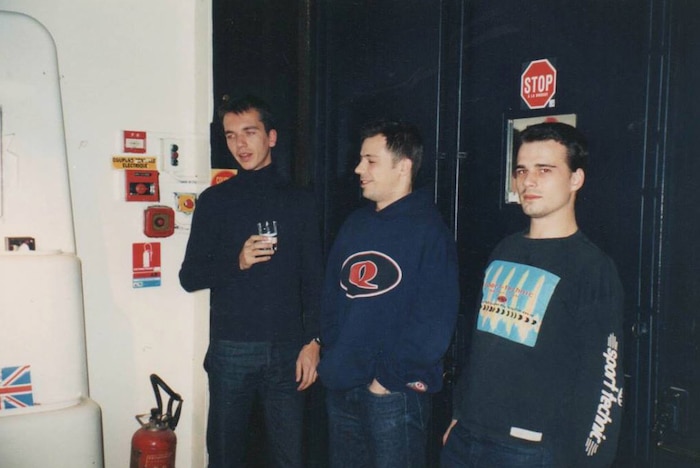
In 1996, parallel to his work at Nova, David Blot launched the Respect parties at the Queen with Fred Agostini and Jérôme Viger-Kohler, the latter working at FG alongside Jean-Yves Leloup on The Happy Hour show. “It was 1996 that really cemented FG’s shift towards house and techno,” Leloup recounts, “the gay identity remained, moving to the background, to make way for a 100% techno/house schedule, when it had mixed up genres for years. By mixed I mean classical and opera in the morning, with house and techno the afternoon. That balanced out the gay audience’s tastes, more or less. Then in the evening there were the personal ads.”33The station’s advertising would carry on the gay torch with sex hotlines ads that went something like this: “If a butcher strikes up a conversation on 36 68 00 99, chances are he knows exactly how to tenderize meat,” all delivered in a wet voice.
In addition to the music played, The Happy Hour filled an important need. “We played a few new releases,” explains Leloup. “But the majority of our content came down to listings for the weekend’s parties... We were one of the only sources of information for the first ravers.”
This sort of media responsibility, as underground as it may it have been, sometimes left the station in awkward situations. “I remember that one time, when Pat Cash, a well-known rave organizer, decided that clearly, we hadn’t been talking about his events enough, and paid us a visit. He showed up unannounced one evening, accompanied by a giant beast, a guy from Spiral Tribe, and some other guy to film the entire thing on a camcorder. He was obviously totally high, wouldn’t let me get a word in and literally held me hostage in the studio, just me and him. He asked his friend from Spiral to stop the music we were playing and to put on some hardcore. Then he squatted the mic to talk about his raves. Some time went by, but my coworkers had understandably called the police and the cops walked in to ‘rescue’ me. Pat Cash’s mood suddenly changed, not only did he obey, he even tried to kiss me… maybe he’d mixed X and coke, who knows. Everyone was laughing, except, well, me!”
The Happy Hour would later be rechristened Global Techno, co-presented by Jérôme Viger Kohler, and later, Jean-Philippe Renoult and Christophe Vix. The show was meant to expose techno culture to the greatest number of people at a time when the authorities associated it with “druggie music” and illegal raves. “With Global Techno, we invited guest artists but also event promoters, science fiction authors, journalists and scientists. It had all the aspects of a cultural magazine, even though it revolved around electronic music,” explains Leloup, still a journalist to this day, as well as the author of Global Tekno alongside Renoult, and Ariel Kyrou, former joint-chief editor of Actuel.
“There was no rivalry between FG and Nova,” states Leloup, “The Happy Hour guests often appeared on La Grosse Boule, or vice versa. We competed in a commercial sense, but it remained fraternal.” Some of the DJs, like Deep or Laurent Garnier, managed to straddle the two frequencies over the course of their careers. “The resident DJs at FG often ended up leaving, whether for Nova or not, because they usually weren’t paid, and if they were, not enough,” adds Leloup.
At the end of the ’90s, in addition to the daily slot A Deep Groove broadcast by DJ Deep, Alex from Tokyo and DJ Gregory, and the garage show Cheers led by Sven Love and Greg Gauthier, two crews emerged, discreetly prefiguring the ghetto and bass explosion that the Parisian club scene would experience ten years later.
“I was part of two crews at the same time,” recounts Crabbe from the duo Jess & Crabbe. “There was Hometown on the one hand – Jess, Kenobi, Julian Del and me – named after the parties that had just been launched at the Rex. We played Chicago sounds, whether deep, ghetto or techno. And I was also part of the Rangerz Crew – Mike Jay, Glock 9, Kris Fonk and MC NAi – a team that started with 100% jungle before rather quickly branching out into 2-step and speed garage.”
At a time when second-hand filtered house music was flooding the airwaves, including to some extent FG’s, this innovative back-to-back Sunday show heralded the future well in advance. “We had this slot to ourselves, so it was easy to make an impact,” says Jess. In 2000, the Hometown nights came to a halt and with them, the radio shows too. Jess & Crabbe spent the next years focusing on production they would later release via Fiat Lux records.
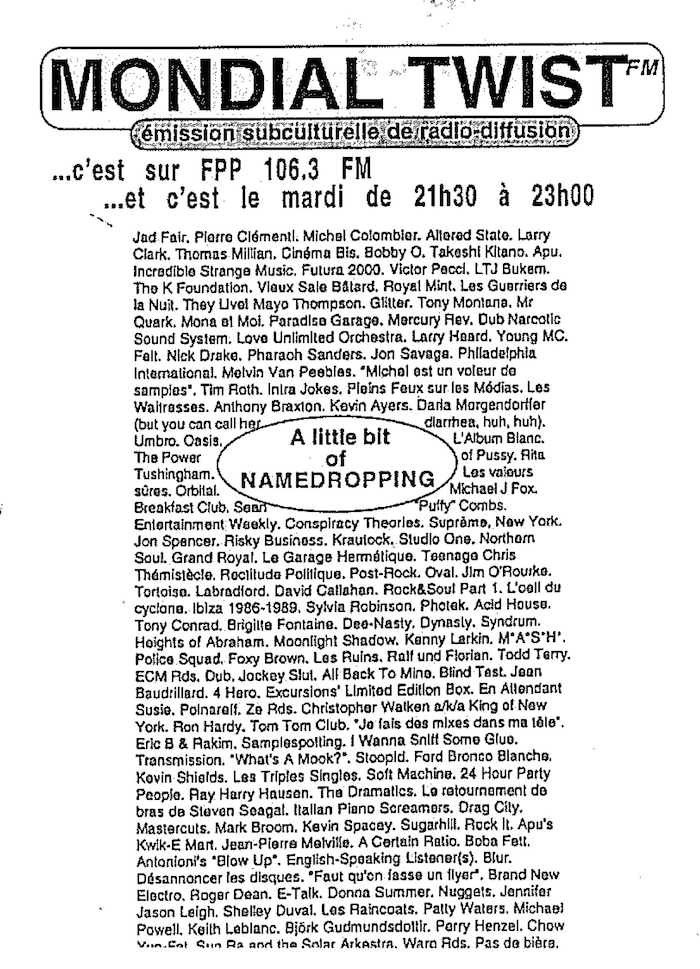
Towards the close of 1993, a show called Mondial Twist began to be aired on Tuesday evenings by a far-left community radio, Fréquence Paris Plurielles, based in the Plaine Saint Denis, just outside of Paris. The name was taken from an English band, World of Twist, a reference for the show’s hosts. They numbered Joseph Ghosn, who’d become a music journalist, musician and most recently, director of the weekly, Grazia; Pierre-Yves Bocquet, who would write two books (Gangsta Rap and Detroit Sampler) under the pen name Pierre Evil, and who has recently been working as a speechwriter for François Hollande; and Ivan Smagghe, who sold records at Rough Trade and was already DJing. In those days, they were students, principally at Sciences Po Paris, versed in the American indie rock descended from hardcore, and/or in a certain stream of English pop – the kind promoted by magazines like Les Inrockuptibles or Magic – eagerly opening up to dance music and hip hop.
The show’s playlist sometimes resembled a mini Nova programming, but with a penchant towards “white rock” rather than “world sounds.” “What Bernard Lenoir was doing at France Inter no longer interested us as much,” says Pierre-Yves Bocquet. “We spent our time at the discount traders or at Rough Trade, always bumping into each other at concerts. I decided to launch a non-profit at Science Po around subculture, and it turned into a radio program.”
Whereas Nova and FG became underground institutions with a telephone line jammed by listeners keen for information on the tracks they’d heard, Mondial Twist transmitted more or less in the void. “The show was an alibi for sharing our discoveries with each other, to practice verbal jousting over our respective tastes, but also the books we were reading and the movies we were watching. We weren’t really sure whether anyone was actually listening,” explains Sébastien Viaud, one of the hosts, “when the phone did ring, it was usually members of the team who hadn’t been able to make it, muffling their voices to pass for real listeners!”
It was probably during these weekly slots of 90 minutes that I most acutely felt the effect that music had on me, understanding the kind of exhilaration it afforded me, something between revelatory grooves, melancholy reflection and light-hearted elitism. The “indie post-ado geek” spirit, as Smagghe would put it: the low profile but consummate passion that characterized the show contrasted with the direction defining the Nova, FG or Générations stations.
Mondial Twist’s do-it-yourself approach stemmed from a dizzying curiosity that jumped from Mike Brant’s no wave to Kenny Dope style rap to the glitch constructions of Oval. Joseph Ghosn recalls: “We were completely hooked on records and subculture, but not in an effort to be cool or stylish, and anyway, the concern around image that prevails today wasn’t at all part of our personal experience,” he chuckles, now an elegant salt-and-pepper topped fortysomething who rarely misses a fashion week.
Through the course of the ’90s, the Mondial Twist team expanded to include other similarly post-indie inspired people like Wilfried Paris, who today spends his time as a musician and a journalist for Chronicart magazine. The founding members eventually peeled off one by one, with the exception of Pierre-Yves Bocquet who found time, alongside his administrative career, to hold the reins until the end of 2002.
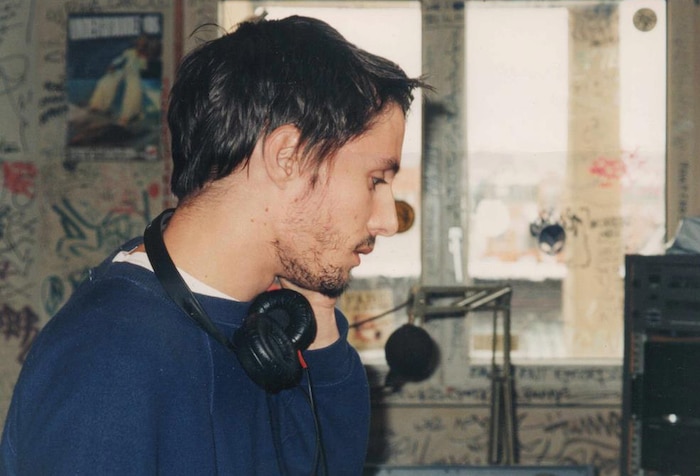
Smagghe had left five or six years previous for Bernard Lenoir, before transferring to Nova where he co-hosted a slot with Loïc, and later set up a show, Mauvais Karma (Bad Karma), an unmixed format of Northern soul and psychedelic rarities. In the fall of 1998, he was offered a daily prime-time slot, Test, that ran for three years. In the end, he quit to start his Kill the DJ label and its parties at the Pulp club, with his producer friend Fany Corral.
Around the turn of the century, high-speed internet made its way to France, changing the world of music fans, who would now spend most of their time downloading off Napster. This was the case for me, and in no time at all I had altogether stopped listening to the radio or, in any case, in a different way. The programming at Nova, like FG and Générations gradually got blander, with more and more advertising, while on my computer I could find all the tracks I hadn’t been able to acquire upon their release, or of which I only had scrappy mixtape versions.
It’s a bit sad to admit, but from the moment I had access to file-sharing sites, my obsession with FM disappeared almost overnight. Others converted to online radio, like the well-known Dutch station CBS/Intergalactic, which began attracting the aficionados of American and European dance music from the end of the ’90s onwards, helping to engineer the massive revival of that fertile scene. But the majority of people began composing their own playlists, their own mixtapes, refining their tastes in the mp3 ocean. Now it was possible to bring burned CDs or personal selections to parties, to quickly whip up compilations for loved ones.
And it’s been pretty much painless, the transition to this near-infinite access to music, more real than ever today. Which is precisely why, when you’re out of luck and really struggling to find an mp3, to the point where you’re prepared to buy it, or even make-do with a low-definition streaming extract – like those good old 30 second Real Audio samples from the beginning of the 2000s – you may find yourself experiencing, let’s face it, a certain pleasure. And then, sometimes, just for the briefest of a during, you may even find yourself saying: it was better before.
Etienne Menu is co-editor in chief of music review Audimat. Between 2004 and 2012, he hosted various music shows on Radio Campus Paris. He has recently produced a series focusing on climate and music for France Culture.
